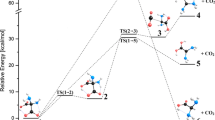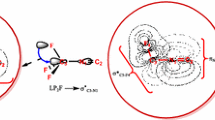Abstract
The equilibrium configuration of the molecules of three derivatives of N-methylnitrosoamine, N,N-dimethylnitramine, and 1-phenyl-1-triazene and their carbanions were calculated by various semiempircal SCF methods and also in the nonempirical 3–21G+ approximation. The optimized geometric parameters of the AM-1 method and the nonempirical 3–21G+ calculation agree with each other and with the experimental data better than the geometric parameters calculated by the MINDO/3 method. The most reliable results are obtained by the AM1 method as applied to the gasphase CH acidity of the N-methylamino derivatives. The scheme for the breakdown of the deprotonation energies of the investigated CH acids into components characterizing the individual atoms and bonds was used to analyze the mechanism of “internal” stabilization of the conjugated carbanions. Comparison of the kinetic CH acidities of the standard hydrocarbons in the basic solution with their deprotonation energies calculated by the AM1 method made it possible to obtain a correlation, the existence of which confirms that there is a single type of mechanism for the stabilization of the carbanions, excluding the solvation effect. The deviation of N-methylamino derivatives from the main line indicates that the solvent has a strong effect on their kinetic CH acidity.
Similar content being viewed by others
Literature cited
D. F. Wright, Chemistry of Nitro and Nitroso Groups [Russian translation], Mir, Moscow (1972).
L. V. Vilkov, A. V. Golubinskii, V. S. Mastryukov, et al., Sovrem. Probl. Fiz. Khim., No. 11. 59–112 (1979).
N. N. Zatsepina, I. F. Tupitsyn, A. I. Belyashova, and N. S. Kolodina, Reakts. Sposobn. Org. Soedin.,12, No. 1. 245–261 (1975).
K. Yoshida and Yano Yuminiko, J. Chem. Soc., Perkin Trans. II, No. 12, 2011–2013 (1988).
J. Chandrasekhar, J. G. Andrade, and P. Schleyer, J. Am. Chem. Sac.,103, No. 18, 5609–5612 (1981).
A. C. Hopkinson and M. H. Lien, Int. J. Quantum Chem.,18, No. 6, 1371–1391 (1980).
K. E. Edgecombe and R. L. Boyd, Can. J. Chem.,62, No. 12, 2887–2891 (1984).
I. F. Tupitsyn, A. A. Kane, Yu. A. Puzanov, and A. Yu. Shibaev, Zh. Obshch. Khim.,59, No. 5, 1145–1150 (1989).
J. J. Novia, J. Mol. Struct. Theochem.,136, No. 3/4, 361–369 (1986).
M. J. Dewar and K. M. Dieter, J. Am. Chem. Soc.,108, No. 25, 8075–8086 (1986).
A. Garnieri and R. Nicolaisen, Z. Naturforsch. A,34, No. 5, 620–624 (1979).
P. Rademacher and R. Stolevik, Acta Chem. Scand.,23, No. 2, 660–671 (1969).
A. Randall Jr. and C. H. Schwalbe, J. Chem. Perkin Trans. II, No. 2, 251–253 (1984).
R. Gordon and R. Ford, The Chemist's Companion, Wiley-Interscience (1973).
G. BInshc, Top. Stereochem., No. 3, 97–192 (1968).
B. Ya. Simkin, B. V. Golyanskii, and V. I. Minkin, Zh. Org. Khim.,17, No. 3–13 (1981).
M. Meot-Ner and S. A. Kafafi, J. Am. Chem. Soc.,110, No. 19, 6297–6303 (1988).
G. M. Zhidomirov, A. A. Bagatur'yants, and I. Abronin, Applied Quantum Chemistry: Calculations of Reactivity and Reaction Mechanisms [in Russian], Khimiya, Moscow (1979).
W. A. Sokalski, P. C. Hariharan, and H. E. Popkie, Int. J. Quantum Chem.,18, No. 1. 189–191 (1980).
N. N. Zatsepina, I. F. Tupitsyn, and A. I. Belyashova, Reakts. Sposobn. Org. Soedin.,11. No. 2, 429–442 (1974).
H. Fisher and H. Kollmar, Theor. Chim. Acta,16, No. 3, 163–174 (1970).
I. G. Tupitsyn, A. A. Kane, Yu. V. Puzanov, and A. Yu. Shibaev, Zh. Obshch. Khim.,59, No. 5, 1151–1163 (1989).
O. A. Reutov, I. P. Beletskaya, and K. P. Butik, CH Acids [in Russian], Nauka, Moscow (1980).
A. Streitwieser, Jr. and L. L. Nebenzahl, J. Am. Chem. Soc.,98, No. 8, 2188–2190 (1976).
Additional information
Scientific-Production Association, State Institute of Applied Chemistry, Leningrad. Translated from Teoreticheskaya i Éksperimental'naya Khimiya, Vol. 27, No. 4, pp. 426–437, July–August, 1991. Original article submitted February 25, 1991.
Rights and permissions
About this article
Cite this article
Tupitsyn, I.F., Egorov, S.A., Puzanov, Y.V. et al. Comparative quantum-chemical investigation of the CH acidity of some N-methyl-amino derivatives in the gas phase and in solution. Theor Exp Chem 27, 367–376 (1991). https://doi.org/10.1007/BF01372508
Issue Date:
DOI: https://doi.org/10.1007/BF01372508




